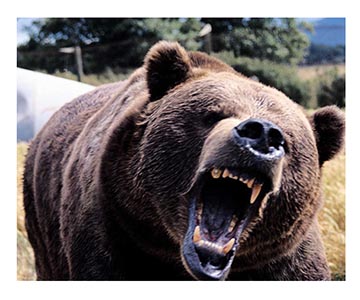

Black Bears Plush Toys
Here is a nice group of Black Bear stuffed animals living at Animals N More.
We have black bear plush stuffed animals in many styles. The image above shows a Black Bear Backpack from Unipak, a Brown Bear from Manhattan Toy Critterology Series, a Brown Bear plush keychain from the Stuffed Animal House, Bronson the plush Black Bear from Ganz, Buffy the Bear and Friend from Boyds, Catcher the Big Brown Bear from Jaag (holding a fish), Honeyfitz the Bear from Russ, Hug'ems Black Bear from Wild Republic, Sugar Bear from Ganz, and little Black Bear Key Clip from Wildlife Artists. There is also a Brown Bear Magnet, a Shining Stars Cream Bear and a Black Bear and Grizzly Bear from Wildlife Artists. You can find some of these bear stuffed animals in our sponsor's Gift Shop.
It is an oddity that the bear, the biggest of the carnivores, eats less flesh than its smaller relatives, the wolf and the fox. Even the great Kodiak bear, a rough brown giant that is nine feet long from tip of tail and weighs upwards of sixteen hundred pounds, will graze like a cow.
Bears will eat meat when opportunity offers, but most of them are not habitual hunters. Except for the polar bear, they feed on almost anything that they can find, including grasses, roots, insects, ants, eggs, mice, nuts and fruits, as well as fish and game. These massive carnivores simply do not eat from a total flesh diet. Heavily built and powerful, bears are for their size among the strongest of animals. They can hold their own against any natural foe. They rarely need to run in fear.
Even at a good distance you can readily recognize a bear by its lumbering gait. Bears are flat-footed and put the whole sole of the foot on the ground when they walk. Though normally slow-moving, they can bustle along in a lumbering gallop if need be. But the bears are walkers rather than runners. Most can climb, but some are too big and heavy to go up a tree. All are good swimmers; the polar bear is particularly well equipped for long periods in the water.
There are a surprising number of different kinds of bears. We place these animals in the family Ursidae. They all have a thick, warm coat of hair, rounded ears, strong claws that cannot be drawn back, and a mere stump of a tail. Most bears are black, but brownish shades are quite common. The white fur of the polar bear is the exception. Bears have poor eyesight and only fair hearing, but a remarkably good sense of smell. Their nose tells them where food is to be had and when the weather is going to change.
Bears are creatures of the Northern Hemisphere; we find only one, the Andean black bear, south of the Equator today, and none in Africa or Australia. Most dwell in northwestern North America and northeastern Asia. In these two parts of the world live the biggest bears. Up the rivers in these regions millions of salmon come every year to spawn. Their life cycle complete, they die and are devoured by the great bears. There is no doubt but that the bears gather to eat the dead and dying salmon; and their large size may be due, at least in part, to this rich diet.
Wintertime sleepers, the bears go into their dens in the fall, when they are quite fat, and do not emerge until early spring. As a rule they go without food for several days before turning in for the winter; and when they come out in the spring they first have a long drink of cool water and then feed sparingly.
Although a bear may sleep soundly through the winter, it does not hibernate in the strict scientific sense of the word. Its body temperature remains nearly normal, and the animal occasionally rouses and comes out of the den on mild days in midwinter. With true hibernators, like the woodchuck, the sleep is a profound lethargy; the body temperature is only a few degrees higher than that of the air.
It is during the winter sleep that the cubs are born. Twins are usual in the bear world, but the rule is not a hard-and-fast one. At birth the young are very small; a two-hundred pound she-bear may have twins that weigh no more than six to twelve ounces each. The cubs grow fast. Their mother lavishes care and affection on them during their baby period, providing for their needs and looking out for their safety. When they are tired they may even ride on her back.
Unlike the kindly mother bear, the father shows no interest in his family whatsoever. He seems a changed fellow from the bear he was earlier, in the courting season. During courtship, bears show great affection for their mates. They often stand up and fondly hug and paw each other. But this is short lived. In one month, the prospective parents have lost all interest in each other.
For the next two years the female is quite indifferent to the opposite sex and concentrates on making a living for herself and her family. As for the male, he goes off by himself. He enjoys his winter sleeping alone.
